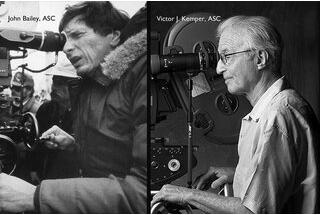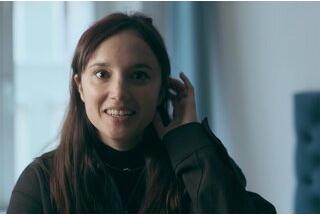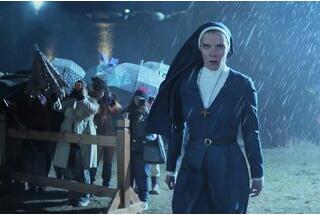Laurent Fénart, AFC, reflects on the shooting of Philippe Faucon’s film, "Les Harkis"
In the late 1950s and early 1960s, the war in Algeria is dragging on. Salah, Kaddour and other destitute young Algerians join the French army as harkis. Leading them is Lieutenant Pascal. The outcome of the conflict suggests Algeria’s independence is imminent. The fate of the harkis seems very uncertain. Pascal disobeys his superiors to ensure repatriation to France for all the men of his unit. Starring Théo Cholbi, Omar Boulakirba, Amine Zorgane
Philippe Faucon’s filming method
Philippe spends a lot of time casting and choosing actors. On set, he is very precise in the choice of frames, focal lengths, camera movements, while remaining careful not to constrain the actor. Once the technical choices have been made, we only do mechanical rehearsals so as not to "wear out" the acting. Philippe generally favors choices that allow scenes to be set up quickly without overly involved technical installations, in order to favor the energy in the actors’ performance. Sometimes he even asks to film the last technical rehearsals as an actual take to try to have immediate access to the actors’ performances. Other times, depending on the difficulties or the particularities of what is to be acted, he is also able to accept shooting a certain number of takes. Most often, he shoots the scene in its entirety, so as not to interrupt the actors’ momentum. Philippe Faucon is a screenwriter, and he writes the lines, but he prefers acting that lives through literal fidelity to the script.

Many exteriors do not necessarily echo an easy shoot.
Shooting exteriors is often a source of constraints, unforeseen events, adaptation, incessant choices… The choice of camera angles, for example, when shooting a long take, to maintain continuity in the direction of light. Or also, even in Morocco, a sun which can be clouded over and can no longer be bridged with the foreground shots…
Or even alley walls that go from shade to sun… Our technical scouting allowed me to take these evolutions into account and to request a precise order of filming of the scenes in the shooting schedule on a particular day.
If this is impossible, for reasons of actors’ availability, for example, the gaffer, key grip, and I, do not hesitate to create a set-up to cut or diffuse the sun on a wall for example... We might even cover an entire alley with diffusion screens to be able to shoot a dawn scene all day long.


Most of the time, I prefer backlighting or sidelights, both for visual reasons and also because it makes it easier to "cheat" with the sun by giving a feeling of continuity for exterior scenes shot over a period of four or six hours. The very tight schedule did not allow us to return twice to the same location, so we had to find a way to bridge shots taken within the same scene but several hours apart.
Sometimes I had to have the sun behind the camera, in the axis, lighting the face. And that allowed me to see that in Morocco, the faces, the colors, the clothes remain quite textured when lit face-on. Even more so when shooting with the autumn sun which sets fairly quickly. But around 4 p.m. the shadows quickly lengthen and rapidly put an end to the day.
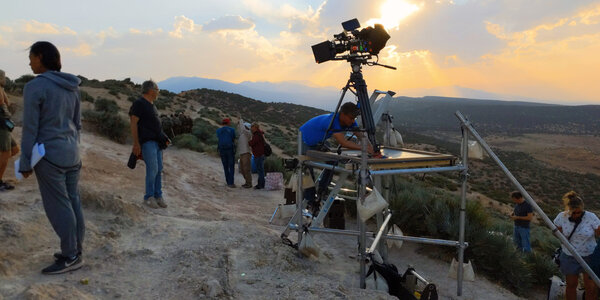
Light and accessories
With thirty-five days of shooting for a war film that takes place largely in the Moroccan Atlas, we had to find solutions and figure out how to do without a large generator, in several very isolated villages with rugged terrain. At the time, we had only two small portable generators.
For the day and night interiors we had Smartlight DMGs, small Aladdins for the kerosene lamp and fire effects, Arri M18s and classic HMIs.
For the kerosene lamps, the gaffer, Lucas Sevrin, skilfully tracked the lights with a pole, in cramped decors.
For day exteriors, we had the sun and mirrors, reflectors, poly, etc. We often used sunlight bouncing off re-diffused mirrors. Often reflectors, Poly or silver reflectors, sometimes just a little reflection to give presence to the face. And also sometimes negative light…
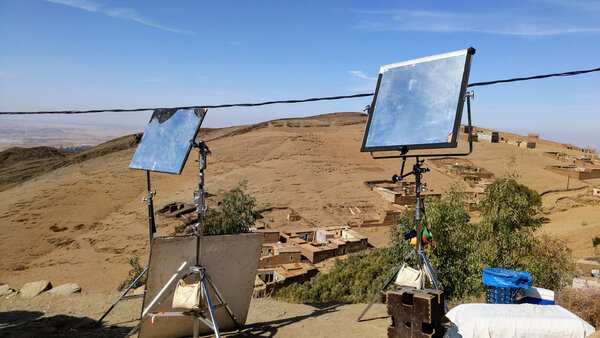
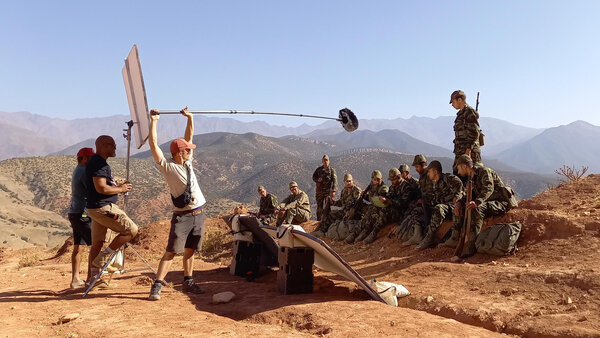
The formats, the focal lengths and the Scope
With Philippe, we never go below 50mm, his favorite focal length, which does not distort, and which gives a very good relationship between the character and the set. It allows for wide shots (by placing yourself far enough away, of course) and close-ups. We also often used 65mm.
I had chosen the RED with a large sensor and the Cooke S4 series. From 50mm, they cover 7K on the full-frame Monstro 8K sensor. It’s as if we were between Super 35 and full frame.
I used a field equivalence table which allowed me to see that the 65mm in 7K corresponded to a 55mm in Super 35 (in vertical field), because we were shooting in "cropped" Scope. I wanted to use the sensor as much as possible to have a "full" image once projected in Scope.
Depth of field on exterior shots
The question of depth of field with a large sensor is more important than in Super 35.
For this film, even on exteriors, I wanted blurs at the threshold of legibility, without necessarily veering into flat tints, so that the backgrounds would be diffracted but recognizable. We wanted to maintain the relationship of the characters to the setting.
Amandine Mahieu, first assistant director, and I, on certain shots with several characters, were careful to keep them sharp while marking the blur in the background.
We often shot at 2.8-1/2 with our two preferred focal lengths, 50 and 65, but sometimes at 4 and 5.6 depending on the value of the shot, the number of characters in the shot, etc.
With a full-frame sensor, at 5.6 to 65 mm, the blurs are still marked.
The rock and the filters
With the RED, you have to add external neutral densities, I took Tiffen which remain more or less consistent in hue, but the green tonality they bring back increases with the progression of the densities. When you end up with N18 or 21, you bring a lot of green. This green seemed to me to correspond to the film, it brought an interesting patina for the 1960s with the RED Monstro. Even on the ocher earth of the Atlas.
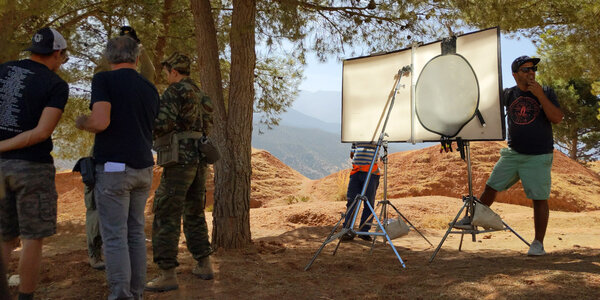
The rock at all costs
For the night scenes in the mountains, or in villages without urban lighting, we made sure that we were always on a rocky background to create a weak nocturnal glow (with diffused SmartLights) in order to avoid flat areas of black. Because we could easily end up with a valley of several kilometers behind the character, impossible to light at night… With night scenes where there is fire, kerosene lamps or military flashlights, impossible to shoot in day-for-night…

When this was not possible, we made plates on rocks lit by a "moon" effect, which we added very simply in post-production in the dark areas of the image. To make the night "alive"...
Stability with a handheld camera
Philippe may like hand-held shots, but for this film, stability was the priority. And we had to shoot quickly in places that were sometimes not very accessible and with very uneven terrain. For the interior tracking shots, we sometimes had a dolly and rails, other times a simple set with a few tubes that Renaud Anciaux, the key grip, is able to create on any kind of terrain.
But for the tracking shots outdoors, I used the Stabe One, with an Easyrig and the "Serene" spring arm. Guided by Renaud for the reverse tracking shots, sometimes over a distance of 20 or 30 meters… It was the Stab One 1, lighter than the 2. This is an interesting tool for tracking shots because once it’s been equipped, without changing configuration, it allows you to quickly readjust for still shots.
A unique look for a minimalistic cinema
Each of Philippe’s film seeks to approach something in its characters through each actor’s performance, without any intentionally visible directorial effects. He avoids recording with several cameras. He strives, on the contrary, to determine, very precisely, the angle and the frame which will best convey the character or what the sequence must express. Thereby, he does not need to over-cut. It’s a directorial style that proceeds by design, it seeks to create a sort of single thread between the camera and the characters. There is never overload or anything forced in his cinema, in the manner of Pialat or Bresson.
(Interview by Brigitte Barbier, for the AFC, translated from French by A. Baron-Raiffe)
 En
En
 Fr
Fr
